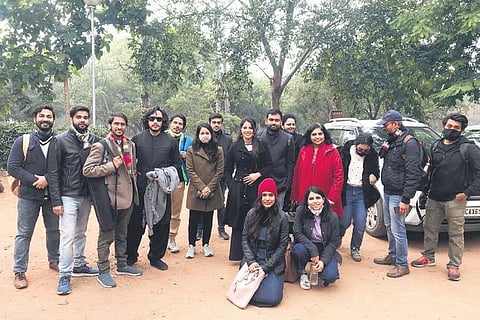

After a gap of five months, Delhipedia — a 2012 start-up that offers an experiential guide to Delhi’s heritage and history — has resumed their physical heritage walks again. The first walk was at the Lodhi Gardens on September 5, the second one is scheduled at the Mehrauli Archaeological Park on September 12 (details below).
Abu Sufiyan, programme head, Delhipedia, says, “Our last heritage walk was in April before the second wave. We had planned for another walk with William Dalrymple at Mehrauli Archaeological Park, but had to cancel it last minute due to the rising cases. Now, we are back in full force.”
Delhipedia’s line-up of storytellers consists of historians, journalists, fashion designers, and architects. “It’s about looking at Delhi through different lens, with the same place but different people doing the walks. Our aim is to have experts in the field conduct the walks, not tour guides. I do mock walks with the storytellers before the actual walk to understand their perspectives and give them inputs to curate a better experience for participants,” Sufiyan adds. Keeping Covid in mind, the walks are limited to 20-25 participants.
One of their unique storytellers is Shah Umair, 26, Owner of Noon Social, a creative agency that campaigns for fashion brands. Umair will conduct the September 12 walk. He is a trained numismatist, who studies and collects Mughal coins. On each walk, he carries 2-3 coins along and gives a brief introduction about them. However, this Gurugram resident has no formal education in history, but used to frequently sign up for walking tours when he lived in Delhi during his internship days in 2017-18.
“I always felt these walks could be organised better. The tour guides would fictionalise the narrative to make the walks appear fancy. So, when Sufiyan asked me if I could conduct walks, I agreed,” adds the storyteller, who has done over 10 walks with Delhipedia at Red Fort, Safdajung Tomb, and Mehrauli Archalogical Park.
The three-hour walk will begin from Dilkusha/Quli Khan’s Tomb and culminate at Zafar Mahal. “Mehrauli Archaeological Park is one of my favourite places in Delhi. This 200 acres has a history of over 1,000 years, which is an amalgamation of different eras. On the walk, I will talk about the small British cottage and the Tomar era ruins here. There is a tomb made for Akbar’s foster brother that MetCalfe repurposed as his summer retreat and called it Metcalfe House.” He will cover Balban’s Tomb, Jamali Kamali Mosque and Tomb (“in famous for being haunted but that’s not the case, they were Sufi saints”), the birth of Sufism, then move to Rajon ki Baoli, and the man who constructed it.
“Also, there is a gateway to Nazir Ka Bagh, a place owned by Yunus, chief eunuch in the arena of the ruler Mohammad Shah. We talk about the importance the third gender had before the British came with their rules. The last point of the walk is Zafar Mahal, the last Mughal monument in Delhi, made by Bahadur Shah Zafar and his father. I will talk about the decline of the Mughals and the story behind the Revolt of 1857. We will walk to the open area where Bahadur Shah wished to be buried, but was eventually taken to Myanmar,” says Umair.
When you study one art form, you can relate to the other forms as well, he feels. “I do the research for the walk on my own. I read a lot of non-fiction; regional books with short stories passed on to the generations, and use them during the walks.” If the location is apt, he delves into fashion facts. “On a walk to Safdarjung Tomb, I spoke about the origins of pajamas, when turbans got replaced by caps, and angrakha replaced by the English shirt that evolved to become the kurta. But Mehrauli Archaeological Park is too big in itself that there is no scope of discussing anything else,” he adds.
DETAILS
ON: September 12; 4:00pm
AT: Heritage walk through Mehrauli Archaeological Park
Meeting Point: Jamali Kamli Parking inside the premises
REGISTER: Instagram @thedelhipedia